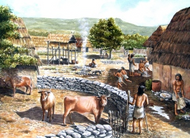Cheese History - Neolithic Age
Posted by The Cheese Man on 18th Aug 2017
History of Cheese Making – Neolithic Age
Cheese consumption predates recorded history, with scholars believing it began as early as 8000 BC, when goat and sheep were first domesticated in the area that is referred to as the Fertile Crescent (present-day Lebanon, Israel, Palestine, Syria, Southern Turkey, Northern Iraq and Western Iran). As a result of the breeding of these animals for their meat and skins, Neolithic people found themselves with a potential source of additional food in the milk that these animals produced for their off-spring. However, it became clear very soon that it could only help with the raising of suckling babies as all adults were lactose intolerant. The lactase that is present in the stomachs of suckling animals and humans and that helps deal with the lactose in the milk, disappears as soon as the stomach receives regular food to deal with.
It probably took many generations of both animals and humans before milking the animals became a more or less established practice. In the course of this, Neolithic man would sometimes find themselves with a surplus of milk. This milk would then be left out and then naturally acidify and break out in curds and whey. They quickly discovered that the curd did not contain as much lactose as milk (due to the fact that bacteria that are always present in areas where milk is produced would break down the lactose to lactic acid and a large proportion of the lactose would be lost in the whey) and could be eaten in modest amounts without making them sick. This opened milk up as a new food source and Neolithic man lost no time in designing technology to be able to separate the curd from the whey. Princeton Professor Peter Bogucki was one of the first to find evidence of this on pottery shards.
For thousands of years Neolithic man made cheese very much in the form of Ricotta today, a loose mass of curd that allowed them to extend the life of milk. Added benefit for the lactose-intolerant adult population was that in contrast to fresh milk this cheese contained a whole lot less lactose as a result of lactic acid fermentation and the extraction of whey. It was not until they experimented with the hard balls of cheese-like product they sometimes found in the stomachs of the very young animals they slaughtered, that harder cheeses came into the picture. By first possibly adding part of these cheese-ball products to heated up milk they managed to make the loose curd stick together. Further experimentation with the stomachs of these young animals will have led them to use pieces of dried stomachs to get the same effect. What they found were enzymes that are naturally present in the stomachs of suckling babies. Mother nature does not like waste and if nothing else would change milk would come into the stomach of these young animals and go straight through even if acidified. The enzyme complex containing chymosin, pepsin and lipase referred to as rennet, grabs the loose bits of curd and binds them together to form a ball. This gives the stomach time to extract all the nutrients from the milk.
To be continued.

